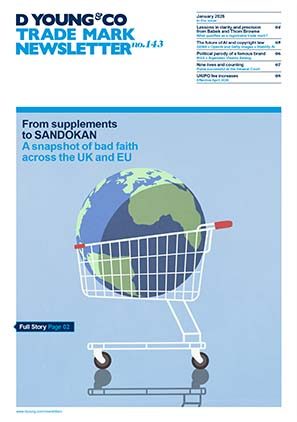Sky skewers Samsung: single letter marks
Samsung applied to register in the UK the mark below, left (together with another mark containing QLED TV) in respect of televisions.

The applications were opposed by Sky, owner of earlier registrations for the mark shown above right, also protected for televisions.
The main thrust of Samsung’s argument was that:
- single letter marks have a low level of distinctive character; and;
- the Sky mark is not a letter Q.
The hearing officer, Oliver Morris, held that both marks comprise a circular element, with an intersecting straight component, crossing the circle in roughly the same place, with the straight components being roughly the same length.
Likelihood of confusion
Although a reputation and passing off were claimed the decision is limited to considering whether a likelihood of confusion would arise under Section 5(2)(b) of the UK Trade Mark Act. Sky filed evidence relating to their use of the mark but given that this was not specifically for televisions, it didn’t really feature in the hearing officer’s thinking.
Visually, taking into account the similarities and differences, the tribunal found that there is at least a medium level of visual similarity. Aurally, the marks were considered identical if seen as a letter Q, pronounced QUEUE.
Conceptually, if perceived as a Q, the hearing officer felt the earlier mark would be identical to the applied for mark (to the extent that letters have a concept), whereas, if not perceived in that way, the marks would be conceptually different (one being a Q the other having no clear concept).
Counsel for Samsung argued that the average consumer would not see the earlier mark as a Q and that it would, instead, be seen as a metallic ring with a glinting effect added to it.
Sky countered saying that it would be clearly and unambiguously perceived as a Q. In addition the evidence filed (although not relied upon by the tribunal) showed that the sign was intended to be seen as Q, that it had been perceived in press articles as a Q, and if there had been any doubt as to the perception, consumers had been educated to see it as a Q.
The hearing officer confirmed that in his view the average consumer will see the letter Q when they encounter the earlier mark. Whilst they will notice its stylisation and that it is more than just a standard font, he agreed that the circle and the intersecting element matches the typical size and orientation of a Q so that the average consumer will see it as such.
Inherent distinctive character
Turning to the inherent distinctive character of the mark, whilst accepting that a single letter Q (for televisions) is unlikely to be regarded as highly distinctive, the hearing officer found no reason why he should accord only a very weak or low level of inherent distinctiveness. Its distinctiveness may be slightly lower than the norm, but not by much, he held.
Direct and indirect confusion
The hearing officer then went on to consider whether there would be a likelihood of confusion distinguishing between direct and indirect confusion, the latter being where the consumer’s mental analysis says “The later mark is different from the earlier mark, but also has something in common with it. Taking account of the common element in the context of the later mark as a whole, I conclude that it is another brand of the owner of the earlier mark”. Slightly surprisingly, the hearing says “Notwithstanding the principle of imperfect recollection, I come to the view that the average consumer will not directly confuse the marks and will at least recall that one mark has some form of stylisation which is not shared by the other plainer mark(s)”. He went on to conclude however that there would be a likelihood of indirect confusion and also for the mark containing QLED TV.
Comment
The decision is to be welcomed and was to be expected, notwithstanding the outcome in some recent UKIPO cases where a likelihood of confusion was not found – see, for example, our report on MASTERCHEF v MISTER CHEF: www.dyoung.com/knowledgebank/articles/masterchef-mister-chef.
The oppositions were upheld with costs of £2,200.
Case details at a glance
Jurisdiction: UK
Decision level: UKIPO
Parties: SAMSUNG ELECTRONICS CO., LTD and SKY PLC
Date: 24 September 2018
Citation: O-585-18
